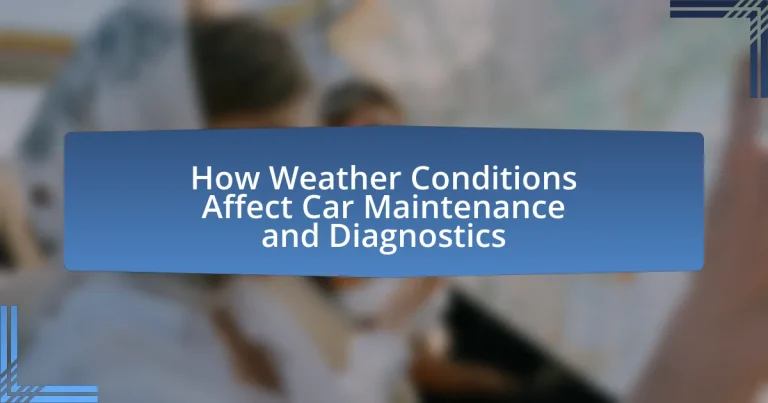The article focuses on how weather conditions impact car maintenance and diagnostics, highlighting the effects of extreme temperatures, humidity, precipitation, and road salt exposure on vehicle performance and component wear. It discusses specific challenges posed by cold and hot weather, including battery life, fluid viscosity, and rust formation, emphasizing the importance of regular maintenance checks in harsh climates. Additionally, the article outlines best practices for car owners to prepare their vehicles for seasonal changes, the significance of proactive maintenance, and the diagnostic challenges that arise due to varying weather conditions. Understanding these factors is crucial for ensuring vehicle safety, longevity, and optimal performance.

How do weather conditions impact car maintenance?
Weather conditions significantly impact car maintenance by influencing the wear and tear on various vehicle components. For instance, extreme temperatures can affect battery performance, with cold weather reducing battery capacity and hot weather accelerating fluid evaporation. Additionally, rain and snow can lead to rust formation on metal parts, necessitating more frequent inspections and protective treatments. According to the AAA, vehicles in regions with harsh weather conditions require more regular maintenance checks, as factors like road salt in winter can corrode undercarriage components. Therefore, understanding local weather patterns is crucial for effective car maintenance planning.
What specific weather conditions affect car maintenance?
Specific weather conditions that affect car maintenance include extreme temperatures, humidity, precipitation, and road salt exposure. Extreme cold can lead to battery failure and thickened engine oil, while extreme heat can cause overheating and fluid evaporation. High humidity can promote rust and corrosion, particularly in metal components. Additionally, rain and snow can lead to water accumulation in critical areas, affecting electrical systems and brakes. Road salt, commonly used in winter, accelerates corrosion on the vehicle’s undercarriage and body. These conditions necessitate regular inspections and maintenance to ensure vehicle longevity and safety.
How does extreme heat influence engine performance and maintenance?
Extreme heat negatively influences engine performance and maintenance by causing overheating, increased wear on components, and reduced efficiency. High temperatures can lead to engine coolant evaporation, resulting in inadequate cooling and potential engine damage. Additionally, extreme heat accelerates oil breakdown, diminishing its lubricating properties and increasing friction among engine parts. This can lead to premature wear and failure of critical components such as pistons and bearings. Regular maintenance, including checking coolant levels and oil quality, becomes essential in hot conditions to prevent these issues and ensure optimal engine performance.
What effects does cold weather have on battery life and fluid viscosity?
Cold weather significantly reduces battery life and increases fluid viscosity. In low temperatures, chemical reactions within batteries slow down, leading to decreased capacity and efficiency; for instance, a lead-acid battery can lose up to 60% of its starting power at 0°F (-18°C). Additionally, engine oils and other fluids become thicker in cold conditions, which increases resistance and can hinder engine performance. This change in viscosity can lead to difficulties in starting the engine and can affect the overall lubrication of engine components, potentially causing increased wear and tear.
How do rainy or humid conditions contribute to rust and corrosion?
Rainy or humid conditions significantly contribute to rust and corrosion by providing the moisture necessary for the electrochemical reactions that lead to metal degradation. When water accumulates on metal surfaces, it creates an environment conducive to oxidation, especially when combined with pollutants like salt or dirt. This moisture facilitates the transfer of electrons, which accelerates the rusting process, as evidenced by the fact that steel can begin to corrode within hours of exposure to water in the presence of oxygen. Additionally, high humidity levels can lead to condensation on metal surfaces, further promoting corrosion. Studies have shown that environments with high humidity can increase the rate of corrosion by up to 50% compared to drier conditions, highlighting the critical impact of weather on metal integrity.
Why is understanding weather effects crucial for car owners?
Understanding weather effects is crucial for car owners because it directly impacts vehicle performance, safety, and maintenance needs. For instance, extreme temperatures can affect tire pressure, with a decrease of about 1 PSI for every 10°F drop in temperature, leading to potential handling issues. Additionally, rain and snow can reduce traction, increasing the risk of accidents, which emphasizes the need for appropriate tire tread and maintenance. Furthermore, understanding how humidity affects battery performance is vital, as high humidity can lead to corrosion and reduced battery life. Therefore, awareness of weather conditions enables car owners to make informed decisions regarding maintenance and safety measures, ultimately prolonging vehicle lifespan and enhancing driving safety.
What are the potential risks of neglecting weather-related maintenance?
Neglecting weather-related maintenance poses significant risks, including increased vehicle wear and tear, reduced safety, and higher repair costs. For instance, failing to address rust caused by road salt in winter can lead to structural damage, compromising the vehicle’s integrity. Additionally, neglecting to check tire pressure, which can fluctuate with temperature changes, may result in decreased traction and increased likelihood of accidents. According to the National Highway Traffic Safety Administration, improper tire maintenance contributes to over 600 fatalities annually. Therefore, regular weather-related maintenance is crucial for ensuring vehicle safety and longevity.
How can proactive maintenance mitigate weather-related issues?
Proactive maintenance can mitigate weather-related issues by identifying and addressing potential problems before they escalate. Regular inspections and timely repairs help prevent damage caused by extreme temperatures, moisture, and other environmental factors. For instance, maintaining proper fluid levels and ensuring seals and gaskets are intact can prevent leaks and corrosion, which are exacerbated by harsh weather conditions. According to a study by the Automotive Research Center, vehicles subjected to regular maintenance experience 30% fewer weather-related breakdowns compared to those that are not maintained. This demonstrates that proactive maintenance is essential for enhancing vehicle reliability in varying weather conditions.

How do weather conditions influence car diagnostics?
Weather conditions significantly influence car diagnostics by affecting vehicle performance and the accuracy of diagnostic tools. For instance, extreme temperatures can impact battery efficiency, with cold weather reducing battery capacity and hot weather accelerating battery degradation. Additionally, moisture from rain or snow can lead to electrical issues, causing diagnostic systems to report false errors. Studies indicate that vehicles in colder climates may experience more frequent diagnostic trouble codes related to engine performance, as cold starts can strain engine components. Therefore, understanding the interplay between weather conditions and vehicle diagnostics is crucial for accurate maintenance and troubleshooting.
What diagnostic challenges arise in different weather conditions?
Diagnostic challenges in different weather conditions include reduced visibility, temperature extremes, and moisture-related issues. For instance, heavy rain can obscure sensors and cameras, complicating diagnostics for systems reliant on visual data. Cold temperatures can cause battery failures and affect fluid viscosity, leading to inaccurate readings in diagnostic tools. Additionally, high humidity can lead to corrosion and electrical failures, complicating the identification of issues. These factors collectively hinder accurate diagnostics and maintenance, as they can mask underlying problems or create false positives in vehicle systems.
How does temperature affect electronic systems and sensors?
Temperature significantly affects electronic systems and sensors by influencing their performance, reliability, and lifespan. High temperatures can lead to increased resistance in electronic components, causing overheating and potential failure, while low temperatures can result in reduced sensitivity and slower response times in sensors. For instance, semiconductor devices typically experience a decrease in performance as temperatures rise, with a 10°C increase potentially doubling the failure rate of components. Additionally, temperature fluctuations can cause physical expansion and contraction in materials, leading to mechanical stress and potential damage in electronic assemblies.
What role does humidity play in diagnostic accuracy?
Humidity significantly impacts diagnostic accuracy by influencing the performance of electronic components and sensors in vehicles. High humidity can lead to condensation, which may cause electrical malfunctions or inaccurate readings from diagnostic tools. For instance, studies have shown that moisture can affect the conductivity of electrical connections, leading to erroneous data that technicians rely on for troubleshooting. This relationship between humidity and diagnostic accuracy underscores the importance of considering environmental conditions when performing vehicle diagnostics.
How can weather conditions lead to misdiagnosis?
Weather conditions can lead to misdiagnosis in automotive diagnostics by affecting the performance and behavior of vehicle components. For instance, extreme temperatures can cause battery failure or affect tire pressure, which may be misinterpreted as issues with the electrical system or suspension. Additionally, moisture from rain or humidity can lead to false readings in sensors, such as those related to fuel or engine performance, resulting in incorrect assessments of the vehicle’s condition. Studies have shown that temperature fluctuations can impact the viscosity of engine oil, potentially leading to misdiagnosed engine problems if not accounted for.
What common symptoms may be misinterpreted due to weather effects?
Common symptoms that may be misinterpreted due to weather effects include engine overheating, battery failure, and tire pressure changes. Engine overheating can occur in hot weather, leading to misdiagnosis as a mechanical failure rather than a temperature-related issue. Battery failure is often exacerbated by cold temperatures, which can lead to the assumption that the battery is faulty when it may simply be a reaction to the cold. Tire pressure changes are influenced by temperature fluctuations, causing drivers to misinterpret low tire pressure as a leak instead of a normal response to colder weather. These symptoms highlight the importance of considering weather conditions when diagnosing car issues.
How can technicians differentiate between weather-related issues and actual faults?
Technicians can differentiate between weather-related issues and actual faults by conducting systematic diagnostics that assess both environmental conditions and vehicle performance. They begin by evaluating the symptoms reported, such as electrical failures or engine performance issues, and then correlate these with current weather conditions, like extreme temperatures or moisture levels. For instance, if a vehicle exhibits starting problems during cold weather, technicians may check the battery and ignition system, as cold can reduce battery efficiency. Additionally, they utilize diagnostic tools to read error codes and perform tests that isolate components affected by weather, such as moisture ingress in electrical systems. This methodical approach allows technicians to identify whether the issue is transient due to weather or indicative of a deeper mechanical fault.

What are best practices for car maintenance in varying weather conditions?
Best practices for car maintenance in varying weather conditions include regular checks of tire pressure, battery health, and fluid levels. In cold weather, maintaining proper tire pressure is crucial as it decreases with temperature, impacting traction and fuel efficiency. Additionally, battery performance can decline in low temperatures, so testing the battery and ensuring connections are clean can prevent starting issues. In hot weather, monitoring coolant levels is essential to prevent overheating, and checking the air conditioning system ensures comfort and functionality. Regularly inspecting wiper blades and using appropriate windshield washer fluid helps maintain visibility during rain or snow. These practices are supported by automotive guidelines which emphasize the importance of adapting maintenance routines to seasonal changes for optimal vehicle performance and safety.
How can car owners prepare their vehicles for seasonal changes?
Car owners can prepare their vehicles for seasonal changes by performing essential maintenance tasks tailored to the specific demands of each season. For winter preparation, owners should check and replace antifreeze, inspect the battery, and ensure that tires are suitable for cold weather, as studies show that tire performance can decrease significantly in temperatures below 7°C. In spring, it is important to inspect wiper blades and replace them if necessary, as visibility can be compromised during rain. Additionally, checking the air conditioning system before summer ensures optimal performance during hot months, where temperatures can exceed 30°C. Regularly changing the oil and filters throughout the year also helps maintain engine efficiency, as recommended by automotive experts.
What maintenance tasks should be prioritized in winter versus summer?
In winter, prioritize tasks such as checking and replacing antifreeze, inspecting the battery, and ensuring proper tire tread depth for better traction on snow and ice. These tasks are crucial because cold temperatures can cause battery failure and reduce tire performance. In summer, focus on tasks like checking the air conditioning system, inspecting coolant levels, and ensuring proper tire pressure, as high temperatures can lead to overheating and tire blowouts. These seasonal maintenance tasks are essential for vehicle reliability and safety, as evidenced by studies showing that proper winter preparation can reduce breakdowns by up to 30% and summer maintenance can enhance fuel efficiency by 10%.
How can regular inspections help in adapting to weather changes?
Regular inspections can help in adapting to weather changes by identifying potential issues that may arise due to varying environmental conditions. These inspections allow for the early detection of wear and tear on components affected by temperature fluctuations, such as battery performance, tire pressure, and fluid levels. For instance, a study by the American Automobile Association (AAA) indicates that extreme temperatures can significantly impact tire pressure, leading to increased risk of blowouts if not monitored. By conducting regular inspections, vehicle owners can ensure that their cars are equipped to handle adverse weather, thereby enhancing safety and performance.
What tips can enhance vehicle performance in adverse weather?
To enhance vehicle performance in adverse weather, ensure proper tire maintenance, including checking tire pressure and tread depth. Properly inflated tires with adequate tread improve traction and handling, which is crucial in rain, snow, or ice. According to the National Highway Traffic Safety Administration, under-inflated tires can reduce fuel efficiency and increase the risk of accidents, particularly in adverse conditions. Additionally, using winter tires in snowy or icy conditions can significantly improve grip and control, as they are designed with specific rubber compounds and tread patterns for cold weather. Regularly checking and replacing windshield wipers and ensuring that headlights and taillights are functioning properly also contribute to safer driving in poor visibility conditions.
How can tire maintenance improve safety in wet or snowy conditions?
Tire maintenance significantly improves safety in wet or snowy conditions by ensuring optimal tread depth and proper inflation. Adequate tread depth enhances traction, allowing tires to channel water away and reduce the risk of hydroplaning, which occurs when a tire loses contact with the road surface due to water. According to the National Highway Traffic Safety Administration, tires with insufficient tread can increase stopping distances by up to 30%. Proper inflation is equally crucial; under-inflated tires can lead to reduced handling and increased tire wear, compromising vehicle stability. Regularly checking and maintaining tire pressure can improve grip and control, especially on slippery surfaces.
What are the best practices for fluid checks in extreme temperatures?
The best practices for fluid checks in extreme temperatures include regularly monitoring fluid levels, using temperature-appropriate fluids, and conducting checks more frequently during extreme conditions. Regular monitoring ensures that fluids remain at optimal levels, which is crucial for vehicle performance. Using fluids designed for extreme temperatures, such as low-viscosity oils in cold weather or high-temperature antifreeze, helps maintain proper lubrication and cooling. Additionally, frequent checks during extreme conditions, such as before long trips in severe heat or cold, can prevent potential issues, as fluids can degrade or evaporate more quickly under these circumstances.


